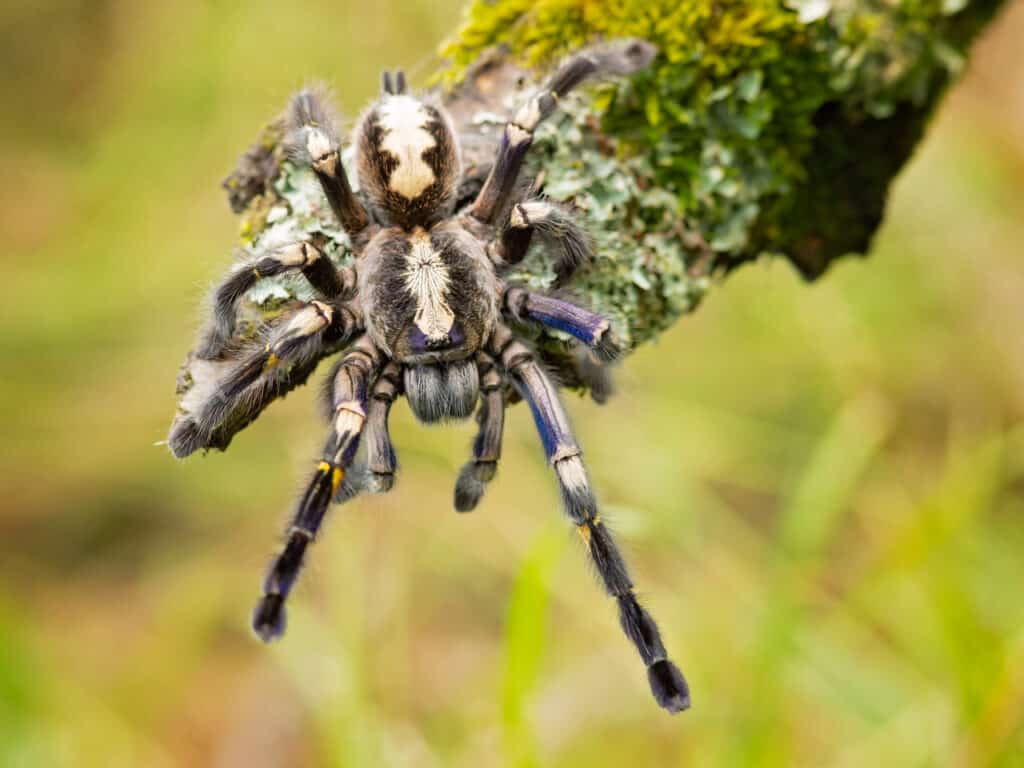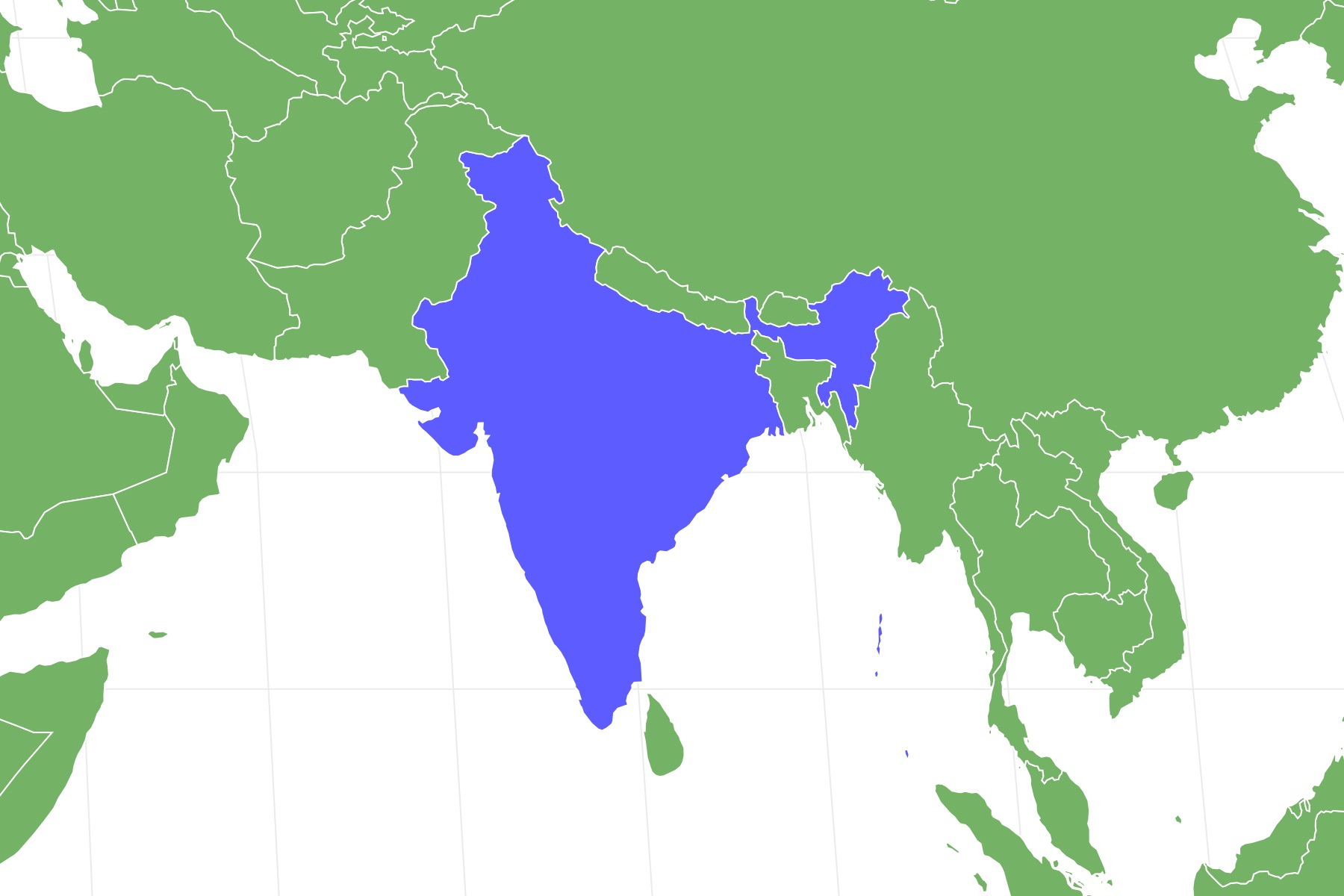Gooty Sapphire Tarantula
Poecilotheria metallica
They can run up a tree trunk surprisingly fast.
Advertisement
Gooty Sapphire Tarantula Scientific Classification
- Kingdom
- Animalia
- Phylum
- Arthropoda
- Class
- Arachnida
- Order
- Araneae
- Family
- Theraphosidae
- Genus
- Poecilotheria
- Scientific Name
- Poecilotheria metallica
Read our Complete Guide to Classification of Animals.
Gooty Sapphire Tarantula Conservation Status
Gooty Sapphire Tarantula Facts
- Prey
- Flying insects, crickets
- Main Prey
- Flying insects
- Name Of Young
- spiderlings
- Group Behavior
- Subsocial
- Fun Fact
- They can run up a tree trunk surprisingly fast.
- Biggest Threat
- habitat loss
- Most Distinctive Feature
- Metallic blue hair
- Other Name(s)
- Metallic blue tarantula, peacock tarantula
- Temperament
- skittish
- Habitat
- forest in southeast India, arboreal
- Predators
- snakes, birds, large spiders
- Diet
- Carnivore
- Lifestyle
- Diurnal
- Location
- southeast India
View all of the Gooty Sapphire Tarantula images!
One of the naturally blue animals in the world.
Gooty sapphire tarantulas are a brilliant blue color. Their unique coloration makes them a popular tarantula in the pet trade. Originally from Gooty, India these fascinating tarantulas are sometimes also called metallic blue tarantulas or peacock parachute spiders. They are a rare tarantula located only in small area of southeast India. Due to habitat loss they are listed as Critically Endangered by the IUCN.
Amazing Gooty Sapphire Tarantula Facts
- Gooty sapphire tarantulas are one of the few naturally blue animals.
- They can have a leg span of 6 inches as adults.
- After a molt they are the brightest blue.
- They do not have urticating hairs like some other tarantulas.
- You can keep more than one in an enclosure as pets.
Gooty Sapphire Tarantula Scientific name
The scientific name of the Gooty Sapphire tarantula is Poecilotheria metallica. In Ancient Greek poikilos means “spotted”, and therion means “wild beast”. They are sometimes referred to as the peacock tarantula due to their bright blue coloration. Other names include Gooty sapphire ornamental tarantulas, metallic blue tarantulas, peacock parachute spiders or just peacock tarantula.
Gooty Sapphire Tarantula Appearance

These medium-sized tarantulas are covered in bright blue hairs, including their legs.
©Milan Zygmunt/Shutterstock.com
These medium-sized tarantulas are covered in bright blue hairs, including their legs. Their bodies have two segments with the head being a tad smaller than their abdomen section. They have long segmented legs with their knee joints appearing yellow. The blue bristly hairs look iridescent with the coloration being brighter right after a molt.
As adults the females can have a leg span of 6-8 inches while the males are a little smaller. Their bodies are more oblong than other tarantulas with longer legs. If they were stretched out on your cell phone their legs would dangle off the sides, that’s a good-sized spider! Besides their 8 legs they have an additional set of appendages called pedipalps. These are used to help pin down prey and as feelers. The males use them during mating.
Gooty Sapphire Tarantula Behavior
Gooty Sapphire tarantulas are fast spiders, when they are observed as pets they skitter around their enclosures. As young they start out as terrestrial animals, living on the ground, hiding in tree stumps and making homes in shallow burrows. As adults they are arboreal and can scoot up trees with ease. They live and hunt in the dense trees of the forest.
Due to the small location of these rare tarantulas they seem to tolerate other spiders of the same breed making them semisocial vs solitary.
If they are threatened they have a tendency to crouch down, making themselves look flat so that the predator will ignore them. Although one would think the bright blue would not be good camouflage, they actually blend in well with the tree bark in certain lighting. If a predator gets too close they will run away quickly.
While New World tarantulas like the California brow tarantula, have urticating hairs that they can flick with their legs at an approaching predator, Gooty sapphires do not have urticating hairs.
Gooty Sapphire Tarantula Habitat
Gooty Sapphire tarantulas only live in one small area of southeast India. They can be found in reserve forest that is less than 40 sq miles (less than 100 square kilometers). This area can be considered a monsoon forest with a really, really wet season (almost constant rain) with a really, really dry season (almost no rain). Gooty sapphires can adjust to both extremes. Most of the time the climate is warm and humid.
As young spiderlings they start out living on the ground but as adults they are arboreal, living in holes in trees. They spend most of their time during both the wet and dry season up in the branches and along the trunks. They are excellent climbers and can make amazing vertical climbs.
Because their habitat is so limited you can find more than one living in close proximity. In captivity you can house more than one adult in a communal enclosure. Other tarantula species are territorial for this and would attack and/or eat one another.
Gooty Sapphire Tarantula Predators and Threats
The main predators of Gooty Sapphire tarantulas are larger spiders, arboreal snakes and birds that may try to pick them off from their tree branch locations.
Gooty sapphires rely on their camouflage to protect them from predators. If threatened they may either crouch down and try to blend in to be avoided or they will flee, running away or quickly climbing further into a tree.
They are venomous and can bite but are more likely to flee than fight. They use their venom to paralyze their prey before eating them. Their venom is harmful to humans and they do bite so if you have one as a pet it is not recommended that you handle them.
What Eats Gooty Sapphire Tarantulas?
The main animals that eat Gooty Sapphire tarantulas are arboreal snakes, birds and larger spiders.
What Do Gooty Sapphire Tarantulas Eat?
Gooty Sapphire tarantulas eat flying insects in the wild and captive ones eat crickets. Captive Gooty sapphires eat about 3-4 large crickets every two weeks or so, eating less right before a molt.
What is the Conservation Status of Gooty Sapphire Tarantulas?
Gooty Sapphire tarantulas are listed as “Critically Endangered” by the IUCN. The IUCN uses the name “Peacock Tarantula” and lists habitat loss as the main threat to the survival of the species. The forest they are from is being heavily used for logging and wood harvesting. A secondary threat is international pet traders that try to capture and breed this species.
Reproduction, Babies, and Lifespan
Male Gooty Sapphires do not have tibial hooks like New World tarantulas but they still manage to get the job done. They are at risk of being eaten by their female mate just like New World tarantulas and they do die shortly after mating. They use the similar technique of creating a sperm web and then transferring the sperm to the receptive female.
Female Gooty Sapphire tarantulas lay around 40-50 eggs each year and wrap up the eggs to create an egg sac. When the spiderlings hatch they spend the beginning of their lives as terrestrial, living on the ground then gradually transition to arboreal life in the treetops.
The life span of Gooty Sapphire tarantulas is dependent on their gender. Females have a life span around 12 years whereas males live closer to 4 years.
Population
It is difficult to get an accurate population count of the Gooty Sapphire tarantulas due to the fact that they live high in the canopies of the forests. The IUCN has estimated that their population is in danger due to the fact that they are only located in one part of the world. The IUCN has them listed as “Critically Endangered” due to habitat loss and international pet traders.
Related Animals
View all 170 animals that start with GGooty Sapphire Tarantula FAQs (Frequently Asked Questions)
How venemous are Gooty Sapphire Tarantula?
Gooty sapphire tarantulas are very venomous and harmful to humans. While there are not any deaths related to humans being bitten the bites can cause nausea, dizziness and sweating.
Are Gooty sapphire tarantulas rare?
Yes, they are a rare species and considered “Critically Endangered” by the IUCN.
How big do Gooty sapphire tarantulas get?
Their bodies are around 2 ½-3 inches long with the females having a leg span of 6-7 inches and the males having a leg span of 5-6 inches.
Can Gooty sapphire tarantulas climb glass?
Yes, actually they can cling to the side of their glass aquarium.
Do Gooty sapphire tarantulas make webs?
Yes, they spin a funnel web which they carefully locate between branches and in holes in trees to catch flying insects.
Are Gooty sapphire tarantulas good pets?
Yes, they are referred to as “display pets” as they are a “look but don’t touch” pet.
Thank you for reading! Have some feedback for us? Contact the AZ Animals editorial team.
Sources
- Tarantulas, Available here: http://tarantulas.com/
- The Tarantula Collective, Available here: https://www.thetarantulacollective.com/caresheets/poecilotheria-metallica
- Red List of Threatened Species, Available here: https://www.iucnredlist.org/species/63563/12681959
- Branson’s Wild World, Available here: http://bransonswildworld.com/indian-ornamental-tarantula/

















